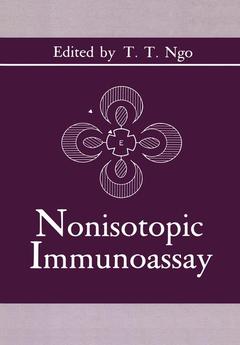Nonisotopic Immunoassay, Softcover reprint of the original 1st ed. 1988
Langue : Anglais
Coordonnateur : Ngo That T.

The basis of all immunoassays is the interaction of antibodies with antigens. The most widely used immunoassay technique is radioimmunoassay (RIA) which was first developed by Yalow and Berson in 1959. The principle of RIA is elegantly simple. It utilizes a competitve binding reaction between analytes and a radio-labeled analog of the analytes (the tracer) for anti-analyte antibodies. In addition to its exquisite specificity, extraordinary sensitivity, good accuracy and precision, ease and rapidity of assay and simplicity of assay development, the applicability of RIA to a wide variety of substances has made it one of the most powerful and versatile analytical methods of the 20th century and beyond. Millions of RIA's are being performed annually on clinical, biological and environmental samples in licensed laboratories. In order to expand the use of RIA beyond the confines of these laboratories to areas like physician's offices, patients' homes, economically less developed countries, agricultural fields, large scale and continuing screening tests for infectious diseases, it has become necessary to develop non-isotopic labels. Indeed the last fifteen years have seen the development of a great number of ingenious non-isotopic labels in immunoassay so that a whole new industry capitalizing on the potential market for non isotopic immunoassays has appeared. It is the purpose of this volume to present in depth, state-of-the-art reviews on techniques used in non-isotopic immunoassays. Topics covered include: (1) Enzyme-labeled immunoassay; (2) Luminescene immunoassay; (3) Immunoassay at liquid-solid interface; (4) Membrane immunoassay and (5) "Particle"-mediated immunoassay.
I. Enzyme-Labeled Immunoassay.- Recent Developments in Enzyme Immunoassays.- Methods for Enzyme-Labeling of Antigens, Antibodies and their Fragments.- Chromogenic Substrates for Enzyme Immunoassay.- Amplification Systems for Enzyme Immunoassay.- Enzyme Immunoassay Based on Partition Affinity Ligand Assay (PALA).- Immunoenzymatic Assays for Peptide Hormones.- Application of Enzyme Immunoassay in Veterinary Medicine: Serodiagnosis of Bovine Brucellosis.- Enzyme Immunoassay of Plan Constituents.- II. Luminescence Immunoassay.- Phycobiliproteins as Labels in Immunoassay.- Chelated Terbium as a Label in Fluorescence Immunoassay.- Fluorescence Polarization Immunoassay: Theory and Application.- Fluorescence Energy Transfer Immunoassays.- Time-Resolved Fluoroimmunoassay.- Phase-Resolved Fluoroimmunoassay.- Solid-Phase Luminescence Immunoassays Using Kinase and Aryl Hydrazide Labels.- Separation-Required Chemiluminescence Immunoassays for Steroids.- Separation Free Chemiluminescence Immunoassay.- III. Immunoassay at Liquid-Solid Interface.- A Primer for Multilayer Immunoassay.- Reflectance Method for Immunoassay on Solid Surfaces.- Interface Immunoassays Using the Evanescent Wave.- IV. Membrane Immunoassay.- Spin Membrane Immunoassay in Serology.- Immunoassay Using Fluorescent Dye-Trapped Liposomes: Liposome Immune Lysis Assay (LILA).- V. “Particle”-Mediated Immunoassay.- Shell-Core Particles for Turbidimetric Immunoassays.- Metalloimmunoassay.- Specific Proteins Analysis by Nephelometry and Turbidimetry.- Nephelometric Inhibition Immunoassay for Small Molecules.- Contributors.
Date de parution : 03-2012
Ouvrage de 512 p.
17.8x25.4 cm
Thèmes de Nonisotopic Immunoassay :
Mots-clés :
Pet; agriculture; biological; development; environment; enzyme; enzymes; fields; infectious disease; iron; membrane; protein; proteins; reaction; tracer
© 2024 LAVOISIER S.A.S.



